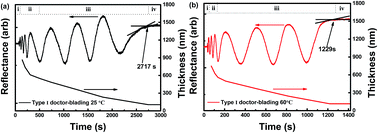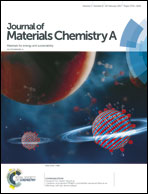Study of ITO-free roll-to-roll compatible polymer solar cells using the one-step doctor blading technique†
Abstract
Extremely simple one-step coating ITO-free inverted polymer solar cells (IFIPSCs) have been fabricated using a novel film deposition method—doctor blading technique, which is completely compatible with roll-to-roll (R2R) manufacturing. Delamination of the interfacial buffer layer (IBL) from the photoactive mixtures is achieved via a spontaneous vertical self-assembly. The performance of one-step doctor-blading IFIPSCs is primarily influenced by the inherent IBL stratification purity rather than the fine donor/acceptor phase separation for the rigid backbone PTB7 system, which is significantly different from that of the conventional two-step doctor blading devices. The surface energy results strongly demonstrate that the formation of the interfacial layer between the ITO-free cathode and the photoactive layer is significantly controlled by the solvent drying time, which determines the self-assembly quality and can be greatly manipulated from 2700 to 1200 s by different substrate temperatures. It's worth noting that the pure interfacial layer formed at low substrate temperatures improves charge separation and transport, whereas high substrate temperatures limit its growth, leading to the decrease of device performance. The detailed relationship between the self-assembly interfacial layer and the internal resistance and capacitance is revealed by impedance spectroscopy. Encouraging power conversion efficiency (PCE) of 6.56% is achieved from simple one-step doctor-blading ITO-free devices at a very low substrate temperature of 25 °C, which is energy saving and appropriate for industrialized R2R production. In contrast, the highest PCE of 7.11% ever reported for two-step doctor-blading ITO-free IFIPSCs was obtained at a high substrate temperature of 60 °C for achieving a fine morphology without regard to the vertical delamination. Furthermore, for crystalline polymer systems like P3TI with a semi-flexible chain, it requires a higher substrate temperature of 40 °C to mediate the balance of vertical self-assembly stratification of the interfacial buffer layer and photoactive morphology to maximize the device performance.



 Please wait while we load your content...
Please wait while we load your content...